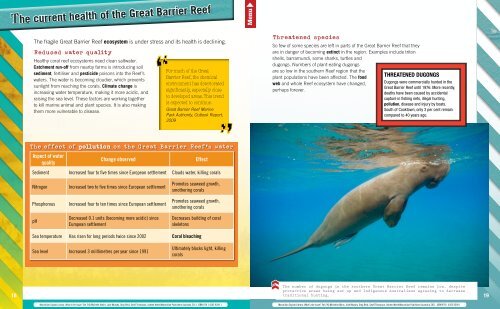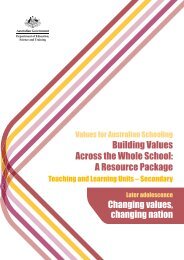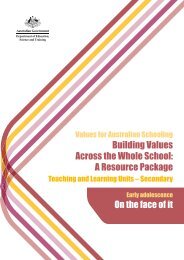GREAT BARRlER REEF - Saint Ignatius' Moodle Community
GREAT BARRlER REEF - Saint Ignatius' Moodle Community
GREAT BARRlER REEF - Saint Ignatius' Moodle Community
Create successful ePaper yourself
Turn your PDF publications into a flip-book with our unique Google optimized e-Paper software.
The fragile Great Barrier Reef ecosystem is under stress and its health is declining.<br />
Reduced water quality<br />
Healthy coral reef ecosystems need clean saltwater.<br />
Catchment run-off from nearby farms is introducing soil<br />
sediment, fertiliser and pesticide poisons into the Reef’s<br />
waters. The water is becoming cloudier, which prevents<br />
sunlight from reaching the corals. Climate change is<br />
increasing water temperature, making it more acidic, and<br />
raising the sea level. These factors are working together<br />
to kill marine animal and plant species. It is also making<br />
them more vulnerable to disease.<br />
For much of the Great<br />
Barrier Reef, the chemical<br />
environment has deteriorated<br />
significantly, especially close<br />
to developed areas. This trend<br />
is expected to continue.<br />
Great Barrier Reef Marine<br />
Park Authority, Outlook Report,<br />
2009<br />
Threatened species<br />
So few of some species are left in parts of the Great Barrier Reef that they<br />
are in danger of becoming extinct in the region. Examples include triton<br />
shells, barramundi, some sharks, turtles and<br />
dugongs. Numbers of plant-eating dugongs<br />
are so low in the southern Reef region that the<br />
plant populations have been affected. The food<br />
web and whole Reef ecosystem have changed,<br />
perhaps forever.<br />
Threatened dugongs<br />
Dugongs were commercially hunted in the<br />
Great Barrier Reef until 1976. More recently,<br />
deaths have been caused by accidental<br />
capture in fishing nets, illegal hunting,<br />
pollution, disease and injury by boats.<br />
South of Cooktown, only 3 per cent remain<br />
compared to 40 years ago.<br />
The effect of pollution on the Great Barrier Reef’s water<br />
Aspect of water<br />
quality<br />
Change observed<br />
Effect<br />
Sediment Increased four to five times since European settlement Clouds water, killing corals<br />
Nitrogen<br />
Phosphorous<br />
pH<br />
Increased two to five times since European settlement<br />
Increased four to ten times since European settlement<br />
Decreased 0.1 units (becoming more acidic) since<br />
European settlement<br />
Promotes seaweed growth,<br />
smothering corals<br />
Promotes seaweed growth,<br />
smothering corals<br />
Decreases building of coral<br />
skeletons<br />
Sea temperature Has risen for long periods twice since 2002 Coral bleaching<br />
Sea level Increased 3 milllimetres per year since 1991<br />
Ultimately blocks light, killing<br />
corals<br />
18<br />
The number of dugongs in the southern Great Barrier Reef remains low, despite<br />
protection areas being set up and Indigenous Australians agreeing to decrease<br />
traditional hunting.<br />
Macmillan Digital Library: What’s the Issue? Set 2 © Michelle Atkins, Julie Murphy, Greg Reid, Geoff Thompson, Ashten Warfe/Macmillan Publishers Australia 2011 ISBN 978 1 4202 9209 1 Macmillan Digital Library: What’s the Issue? Set 2 © Michelle Atkins, Julie Murphy, Greg Reid, Geoff Thompson, Ashten Warfe/Macmillan Publishers Australia 2011 ISBN 978 1 4202 9209 1<br />
19







